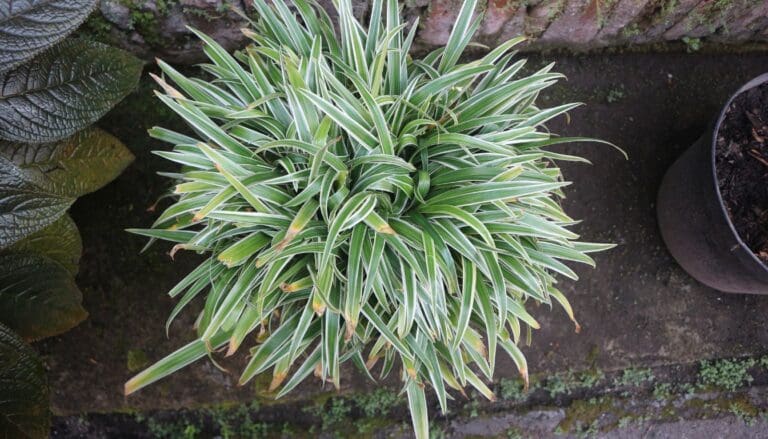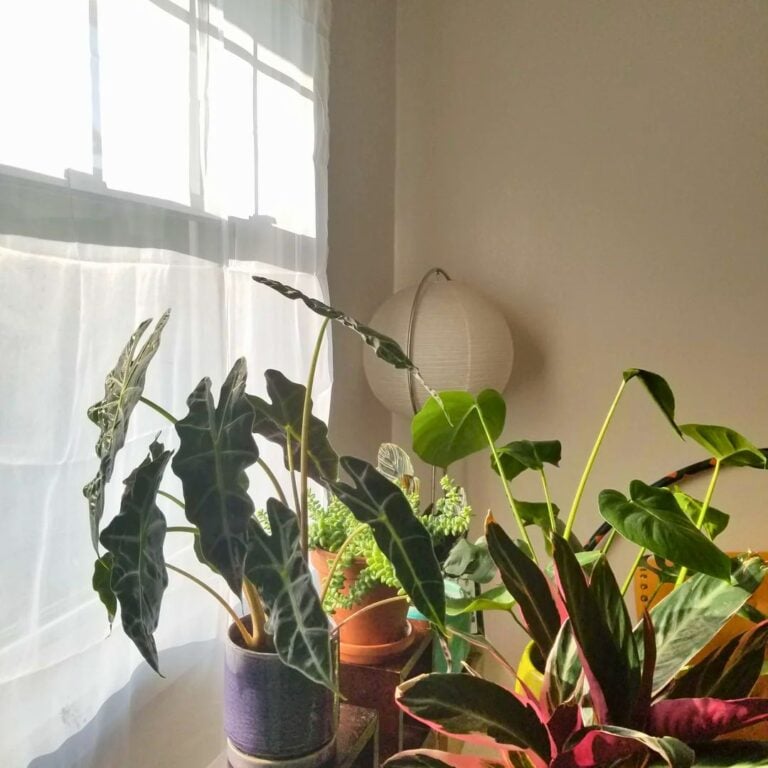Cordyline Plant Care Guide: Tips For Keeping Them Healthy
Cordylines, with their bright colors and striking foliage, have become my absolute gardening obsession. I mean, who wouldn’t fall in love with those vibrant leaves? They’re the perfect touch of the tropics for any garden or living room – yes, they double as fabulous houseplants too!
Have you ever wondered how to keep these beauties thriving? 🤔
Let’s talk about the easy-peasy care these plants require. I’ve found that with just a bit of tender love and care, they can grow up to 10-20 feet tall and bring life to your garden year-round. They’re pretty low-maintenance, but they do love the warmth – kind of like sunbathing on a beach without getting sand everywhere.
Are you ready to bring some Hawaiian charm to your space with these evergreen shrubs?
Alright, don’t be shy – let’s dive right into making your cordyline plants the envy of the neighborhood!
Got any cool tips or fun experiences with your own cordyline plants? Drop them in the comments! I’m all ears. 🌱😄 And if you find this guide as handy as a pair of gardening gloves, be sure to give it a share!

Please note: Simplify Plants is reader-supported. As an Amazon Associate, I earn from qualifying purchases made by our readers with no extra cost added to you all! Some links in the post are affiliate links and I get a commission from purchases made through links in the post.
Types of Cordyline Plants
Have you ever seen a Cordyline plant that made you go “Wow!”? 😉 These stunning plants come in various types, each with its own flair and style. Let’s dive into some of the popular ones—you might just find your next green buddy!
- Cordyline ‘Harlequin’: Imagine leaves splashed with green, white, and pink, like they’ve been to a paint party! 🎨 Perfect for adding a pop of color to your tropical garden.
- Cordyline ‘Maria’: She’s elegant with long, sword-shaped leaves dressed in dark green with a cheerful yellow margin—oh, so chic!
But wait, there’s more! 👇
- Cordyline indivisa: Known as the Mountain Cabbage Tree, this compact variety has purple-tinged foliage and grows to a cuddly 3-6 feet tall.
- Cordyline fruticosa: AKA the Ti or Hawaiian Ti plant, medium in size but grand in presence, growing up to 10-15 feet! 🌴
Do you have a favorite type already, or are you as indecisive as I am when there are too many amazing options? 😅 Can you picture these beauties jazzing up your home or garden?
Go on, share in the comments which one you’d love to adopt! And if you already have a Cordyline, drop a pic; let’s spread some plant joy! 🌿✨ #CordylineCraze
Location and Light Requirements
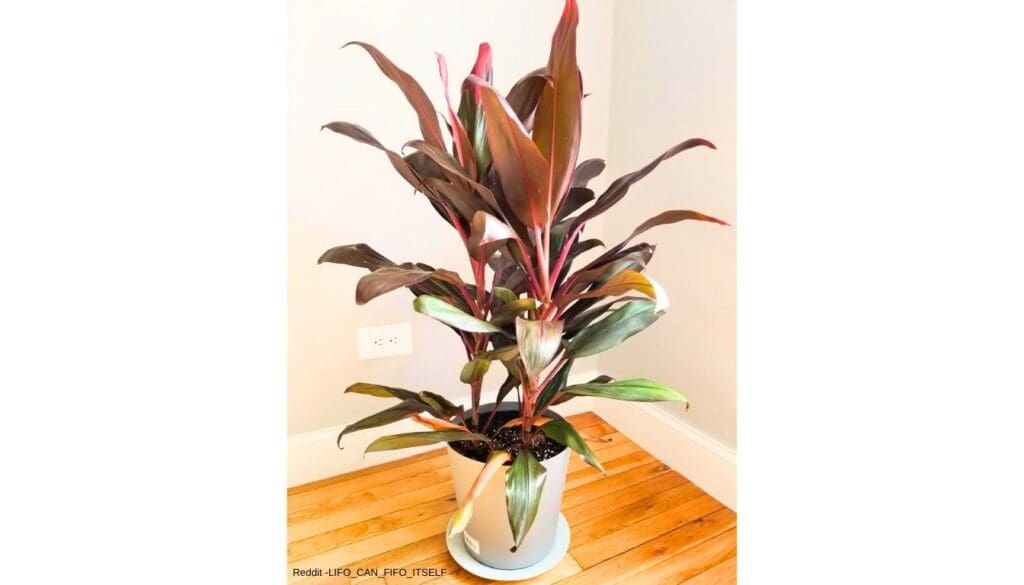
When I’m setting up my Cordyline’s new home, getting the light just right is key. Let’s talk lumens and location! 🌞🌿
Indoor Lighting Conditions
For my indoor Cordyline crew, I’ve found they’re pretty chill with indirect light, but they do have some preferences. Bold move for a plant, huh? Here’s the scoop:
- Green-leaved Cordylines: They’re the sunbathers of the family and can soak up full sun without throwing shade. ☀️
- Colored Varieties (think Red Star or Electric Pink): These divas prefer the spotlight to be less intense, so partial sunlight or light shade will keep their colors poppin’. 🌈
Have you heard the gossip about windowsill woes? Direct sun can sometimes be too much of a good thing, so if you’re seeing a leaf-tan gone wrong (a.k.a. leaf burn), it might be time to shuffle your plant a tad away from the sun.
Outdoor Planting Spots
Now, let’s take it outside! Choosing the perfect spot in the garden is like picking the best seat at a picnic. Here are some quick tips:
- Well-Draining Soil: If my soil’s too clingy (doesn’t drain well), I add compost, sand, or grit to help it loosen up.
- Partial Shade to Full Sun: Just like inside, it depends on the leaf color. My green-leaved buddies can bask in the full sun, but the colorful folks need a bit of shade from scorching rays.
Ever had that “caught in the rain” moment when you’ve planted your Cordyline in the perfect spot, and then the weather pulls a fast one? Talk about drama! But seriously, Cordylines can handle a bit of weather mix-up as long as the spot is well-chosen.
Watering and Humidity
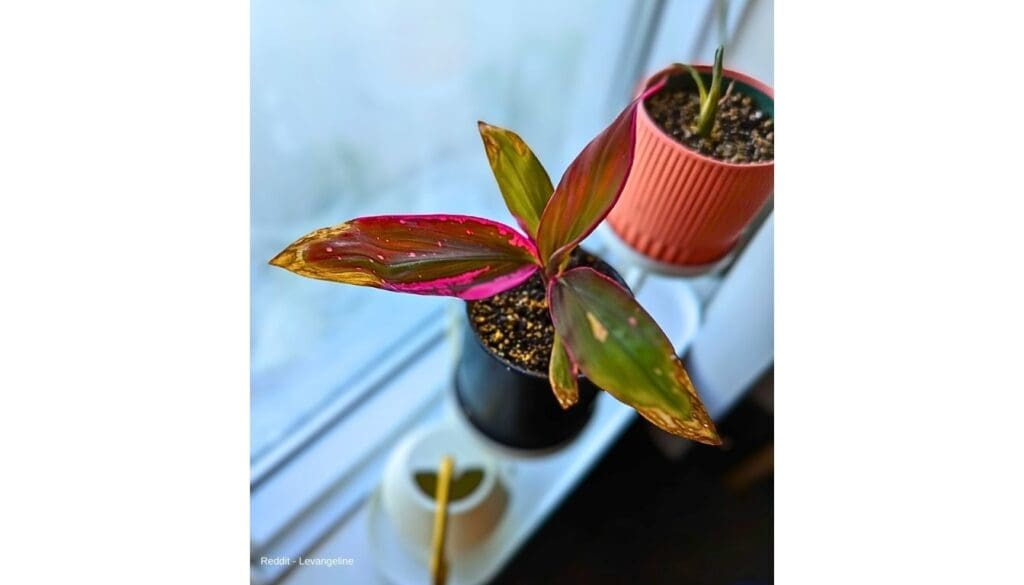
Keeping your Cordyline happy is all about striking the balance between hydration and humidity. Let’s dive right into getting that watering schedule just right and making sure the air isn’t too dry or too damp for our tropical friends!
Watering Frequency
Did you know that your Cordyline is like me when I hit the gym? It’s thirsty but doesn’t like to be drowned! Water me only when my topsoil feels dry, which is about the top 25-50% of the pot. It’s like checking a cake with a toothpick – if it comes out clean, it’s time for a drink! 🍰💧
In practical terms:
- Check the topsoil weekly
- Water thoroughly until it runs out of the drainage holes
- Wait until the soil dries out before watering again
Adjusting for Seasons
Hey, ever notice how you switch up your wardrobe with the seasons? Your Cordyline does the same with its water needs. 💦👕 In the summer, it’s all about staying hydrated, but when winter rolls around, your plant prefers to keep it cool and cut back on the drinks.
Here’s a quick cheat sheet:
| Season | Watering Approach |
|---|---|
| Spring | Regular watering, increase as temperatures rise |
| Summer | Frequent watering, it’s party time for growth! |
| Fall | Begin to reduce frequency, it’s getting chilly |
| Winter | Sparingly water, think of it as a plant hibernation |
Humidity Considerations
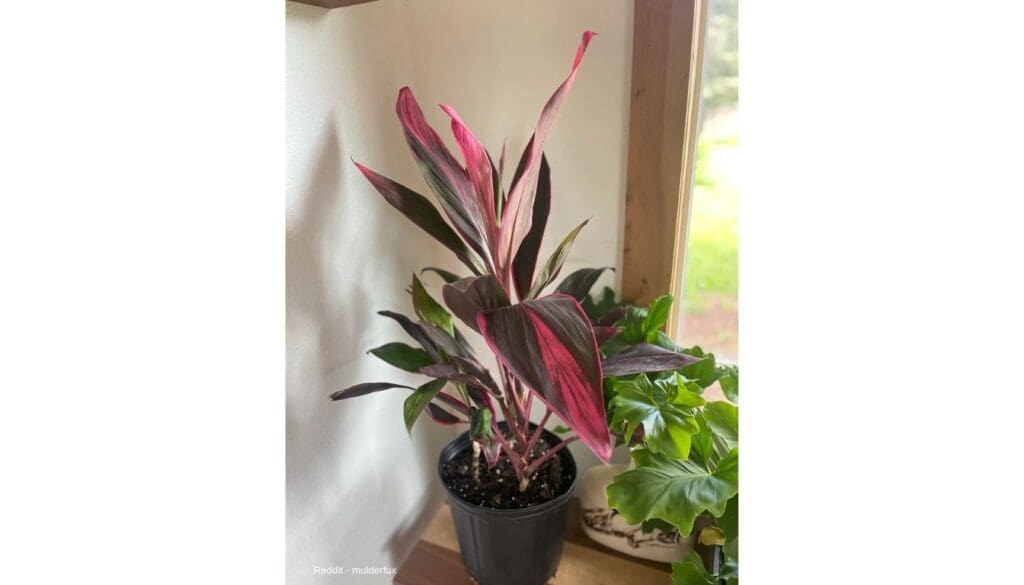
Who doesn’t love a spa day with a tropical mist for that glow-up? 🌿✨ Your Cordyline is the same! It adores high humidity.
So, if your home is drier than my humor on a Monday morning, consider boosting humidity around your plant. Maybe keep it company in the bathroom during a hot shower, or get it a chic humidifier – it’ll feel just like it’s in the tropics!
To amp up the humidity:
- Mist your plant: A light spritz daily
- Use a humidifier: Especially in dry conditions
- Group plants together: They can hum ‘Kumbaya’ and share moisture!
Remember, every Cordyline is an individual with its own vibes and preferences. Adjust watering and humidity to your environment and watch your plant thrive. Share your own tips or any fab results in the comments! Got a trick up your sleeve? Let’s grow together! 🌱👍
Soil and Planting
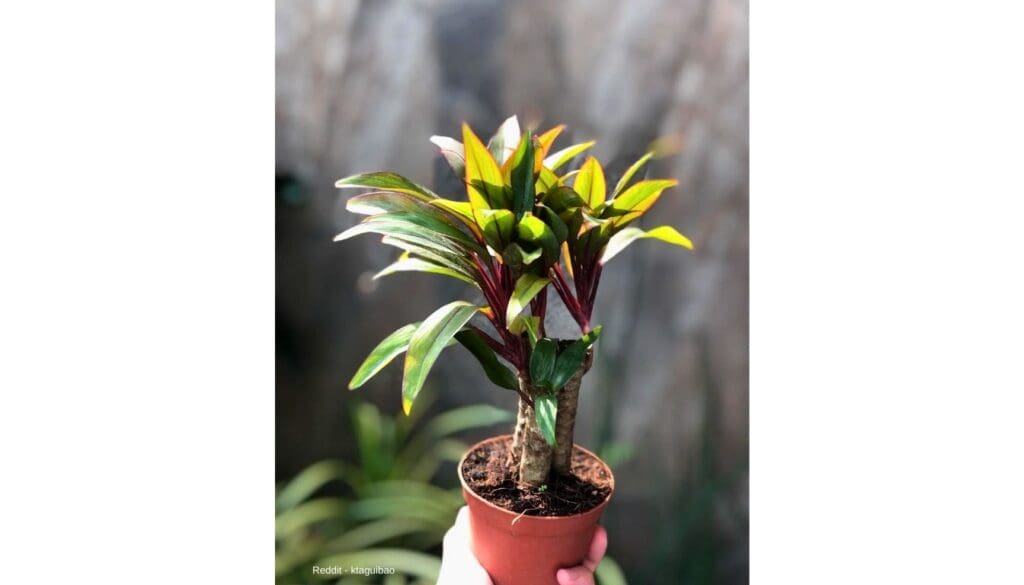
Alright, fellow green thumbs! Let’s talk dirt—specifically, the kind that keeps our Cordyline friends happy. We’re zeroing in on soil composition, potting and repotting, and not forgetting the pivotal drainage. Got your gardening gloves on? 🌱
Soil Composition
I can’t overstate how much Cordylines love rich, well-draining soil. It’s like their favorite dessert—it’s all about balance.
Aim for a mixture that’s one part peat, one part perlite, and two parts potting mix. It’s not just about the ‘yum’ factor; this combo ensures the roots get the right amount of air and moisture.
Have you struck the perfect blend? Share your mix in the comments! 😉
Potting and Repotting
Now for potting—think of it as Cordyline’s ‘me’ time. They need enough space to stretch out their roots.
When choosing a pot, go for one that’s slightly larger than the current one. As for repotting, I like to play house flipper with my plants every two years or so. It keeps them from being root-bound and gives me the chance to refresh the soil.
Ever spotted your Cordyline busting out of its pot? What was that like?
Drainage
If there’s one drama Cordylines could live without, it’s soggy soil. So, ensuring good drainage is key. Holes at the bottom of the pot? Absolutely essential! Sometimes I’ll add a layer of gravel at the base for extra oomph.
Remember, a plant sitting in water is a no-go—unless you’re growing rice, right? 😆 What are your top tips for preventing waterlogged woes?
Fertilization and Growth

I’ve found that giving my Cordyline plants the right mix of nutrients really boosts their growth and vibrancy! Let’s dig into the best ways to feed these beauties. 🌿✨
Fertilizer Choices
When it comes to fertilizers, I choose all-purpose mixes that are high in nitrogen. This encourages lush, green growth. If you’re into organic options like me, compost or worm castings make great choices too!
Feeding Schedule
I stick to a bi-weekly feeding routine during the growing season. Just a heads up—cut back on fertilization in the cooler months. Did you know giving your plant too much food can be just as bad as not enough?
Signs of Nutrient Deficiency
Yellow leaves can be a cry for help! 😲 They often tell me when my Cordyline is lacking nutrients. Keep an eye out for stunted growth or a lackluster appearance, too. Isn’t it amazing how plants communicate with us?
Ever seen your Cordyline throw a tantrum when it’s hungry? Share your stories in the comments! 🌱💬
Pruning and Maintenance
Keeping your Cordyline plant pruned and tidy isn’t just about good looks—it’s essential for its health and vigor. I’ll share with you the techniques I use to keep my beloved green buddy in tip-top shape!
Pruning Techniques
When it’s time for a little haircut, I grab my pruning shears and get to work. Here’s how I do it:
- Leaf Stems: I cut the leaf stem as close to the base as possible at a slight angle.
- Larger Branches: If there’s a need for some heavy-duty work, I use loppers for a clean cut.
Remember, always water your plant after pruning to help it bounce back!
Cleaning Leaves
Who doesn’t love a dust-free plant? 🌱 To clean the leaves, I prefer using a damp cloth and gently wipe the surface. It’s like giving my Cordyline a mini spa day! Plus, it’s a great way to inspect for any hitchhiking pests.
Disease Prevention
Speaking of pests, keeping an eye out for critters and signs of disease is key to a healthy Cordyline.
I check my plant regularly and if I spot anything suspicious, I treat it with the appropriate pesticide.
Prevention is better than cure, right?
Got any pruning prowess or maintenance tips for Cordyline plants you’d like to share? Drop them below; your green-thumb wisdom could help others! 📢👇
Pest Management
I know it’s no fun finding uninvited guests on our beloved Cordyline plants, but don’t fret! Managing pests is a breeze with the right tips at your fingertips. 🌿😊
Common Pests
My Cordyline has had its fair share of crawly critters, and I’ve got the scoop on who these tiny trespassers usually are:
- Spider Mites: Get out the magnifying glass—you’ll need it to spot these tiny nuisances weaving their fine webs.
- Mealybugs: These sticky white pests can turn my green retreat into a fluffy mess.
- Scale Insects: Hard to budge, they’re like the clingy friends of the insect world. You’ll find them as little bumps on stems and leaves.
- Aphids: They’re famous for their love of gossip and sap, congregating where the leaves are tender.
Organic Controls
I’m all about keeping things green and clean, so here’s how I deal with pests the organic way:
- Ladybugs: I like to think of them as my miniature knights in shining armor.
- Lacewings: The unsung heroes—silent but deadly to garden pests.
- Neem Oil: My go-to for a plant spa day—it’s like a soothing bath that pests just can’t stand.
- Soapy Water Spray: The old-school method. Simple, yet surprisingly effective.
Chemical Treatments
When the bugs just won’t buzz off, it’s time to bring out the big guns. But remember, always read the directions and use sparingly:
- Insecticidal Soaps: They’re the bouncers of the plant world, showing pests the exit.
- Pesticides: Like sending in the pest control SWAT team—use as a last resort!
Have you had any bug battles with your Cordylines? Drop your epic tales and top tips in the comments! 🐞🌱✨ And don’t forget to share this with your green-thumbed buddies!
Propagation Methods
Are you ready to multiply your Cordyline collection?
I’m about to share some tried-and-true propagation methods that work wonders for these striking plants.
Whether you’re a propagation pro or a beginner, these tips will get your Cordylines thriving in no time!
Seed Propagation
Starting by seeds is like attending a plant baby shower – it’s all about the anticipation!
First, you’ll need to nab some fresh seeds from your mature Cordyline during their main debut in autumn or early spring.
Sow them in a well-draining mix and cover the container lightly – think of it as tucking them in with a see-through blankie.
Patience is key; sprouting can take a while, but the wait is worth it!
Stem Cuttings
Who needs cloning machines when you have stem cuttings?
Grab a pair of sharp shears and snip a healthy stem about 6-8 inches long, just below a node.
Strip the runway (aka the stem) of any excess leaves leaving just a couple of top models to strut their stuff.
Plant it in your mix, and don’t forget to water it. In a few weeks, you might just see new growth, signaling your success!
Division
I think of division as giving my plants a roommate split.
Find a comfy Cordyline with a sizeable girth and gently separate it at the roots to create smaller, independent plants.
It’s like a magic trick, except you get more plants instead of rabbits.
Make sure each new section has its own roots and foliage, replant them, and voila, your plant family just grew!
So, tell me, which propagation method will you try first? Drop a comment and let me know or share any of your tips! 👀🌱 Don’t forget to share this with your plant-loving pals, too – they might just have some propagation tricks up their sleeves!
Troubleshooting Common Issues
I’ve had my fair share of houseplant hiccups, just like you probably have. But don’t worry! Here are some quick fixes for those pesky problems that our beloved Cordyline plants seem to run into. Let’s tackle them one by one, shall we? 🌱
Yellowing Leaves
Have you noticed your Cordyline’s leaves turning yellow like a banana past its prime?
The culprit is often overwatering. Soggy soil can suffocate those roots and cause discoloration. 😱 Here’s what you can do:
- Allow the soil to dry out slightly between watering sessions.
- Check that the drainage is on point—no plant likes wet feet!
Quick Check:
- Is the soil wetter than a sponge in a rainstorm? Cut back on watering!
- Do you have drainage holes in the pot? No? Time for a quick DIY or a new pot!
Root Rot
Root rot is about as fun as finding a worm in your apple—yuck!
This sneaky issue happens when too much water leaves the roots waterlogged. 🤢
If your Cordyline’s leaves are turning brown or yellow or the stems are feeling mushy, here’s the drill:
Steps to Triumph Over Root Rot:
- Remove the plant from the pot.
- Trim away any black or mushy roots.
- Repot with fresh, fast-draining soil in a clean pot.
Remember, if your plant’s roots are more rotten than a forgotten jack-o’-lantern after Halloween, it might be a goner.
Leaf Drop
Okay, it’s not autumn, so why is your Cordyline losing leaves?
Underwatering could be stressing it out—it’s one thirsty plant. 🌞 Here’s how to keep those leaves lush and attached:
- Watering Routine: Stick a finger in the soil; if it’s drier than a comedian’s wit, it’s time to water.
- Humidity Check: If your air is drier than a talk-show host’s humor, consider a humidifier or pebble tray for that tropical vibe!
Quick Tips:
- Crispy leaves? Time for a drink!
- Drooping like a sleepy puppy? Check moisture levels!
Did I miss any issues you’ve faced with your Cordyline? Share your stories and what you did to save the day. If you’re smiling at your problem-free plant after reading this, hit that share button—it’s time to spread some leafy love! 🌿😊
Winter Care Tips
I’ve got some snuggly advice to keep our Cordyline friends warm and toasty during the chilly months.
Isn’t it great how these stunners can add a splash of tropical vibes even when it’s sweater weather outside? Let’s dive into keeping them perky when it’s more brrrr than burble!
First things first, location, location, location!
If your Cordyline is outdoors and mobile, move it to a spot that’s sheltered from the frost. Near a south-facing wall is perfect for catching those fleeting winter rays. ☀️
Now, let’s talk soil moisture.
It’s tempting to keep the watering can busy, but in winter, Cordylines like their soil like a good pound cake – moist, not soggy!
So, I ease up on watering to avoid root rot.
But what about those of us in cool climates? 🌨️
If my green beauty is planted in the ground, I give it a nice blanket (mulch, I mean!) to keep its feet warm. Just like socks for us, a bit of mulch can go a long way for your plant’s roots.
Here’s a quick rundown:
- Shelter: Move potted Cordylines to a protected area.
- Water Wisely: Reduce watering and make sure drainage is impeccable.
- Mulch: Apply a generous layer of mulch around the base for insulation.
Cordylines can be drama-free with just a little love and care from you! Have you tried these tips or have some of your own? Share your winter wisdom with me! 😊 And hey, don’t let the cold weather make you forget to share your success stories in the comments below. Let’s grow together! 🌱
FAQs on Cordyline Care
Wondering how to keep your Cordyline looking lush? Let’s dig into some common questions you might have:
Can I leave my Cordyline in the dark?
I totally get the desire to flex those interior design muscles, but Cordylines thrive in bright, indirect light. A little shade is okay, though just an hour of sunshine in the morning or evening can work wonders!
How often should I water my Cordyline?
Think of it like making coffee. Wait for the soil’s top to dry out a bit before giving it a drink. Less water in the cooler months, folks – no one likes soggy feet, right? Especially not your Cordyline!
What about pruning?
A haircut every now and then keeps your Cordyline shipshape. A healthy plant should have stems of varying heights, making for a lush, tropical vibe! ✂️🌴
Is it hard to make Cordylines bloom?
Patience is key! If they’re happy and mature, they might surprise you with flowers. Ensuring they’re at the right maturity when you buy them ups the chances. 🌸
Any tips on potting?
Oh, you bet! Good drainage is essential. Think of it as the difference between a comfy, airy bed and a damp, clumpy mattress. Your Cordyline prefers the first one, trust me!
Don’t forget, your Cordyline’s all about that tropical goodness. Share your own tips and photos in the comments – I love seeing your plant babies thrive! 📸💚 #CordylineCare
Conclusion

Isn’t it amazing how a little tender love and care can transform your Cordyline from just “meh” to “wow”?
My journey with these vibrant beauties has been quite the adventure. Let me give you the scoop on wrapping up your Cordyline care routine.
First off, I always make sure my plant pals have good drainage.
Waterlogged roots? No thank you! It’s all about that perfect sip, not a swim, for our rooty friends. 🏊♂️
I’ve found that bright, indirect light works wonders for keeping those leaves as colorful as a sunset. 🌇
But look out for too much direct sun—unless you’re going for the “crispy” look (spoiler: not a good look for plants!).
And remember, like us, Cordylines have their preferences.
Some like it hot, some like it cool. Figuring out what makes your plant tick is part of the fun, right?
Tag me in your plant pics or drop a comment below—let’s celebrate our Cordyline triumphs together!
Who’s got the lushest leaves in town? Is it you? Share your secrets! 🌟
Happy planting, and don’t forget to share this with your plant-loving buddies! 💚 Let’s spread the leafy love!
Recommended Garden Supplies
| Product Image | Our Recommended Gardening Supplies | Check Offers! |
|---|---|---|
Top Top
Top
Top
Top
Top
Top
Top
Top | rePotme Houseplant and Tropical Classic Potting Soil Mix | Check Offer On Amazon |
 Top
Top
Top
Top
Top
Top
Top
Top | Espoma Organic Indoor Plant Food | Check Offer On Amazon |
 Top
Top
Top
Top
Top
Top
Top
Top | GooingTop LED Grow Light 6000K Full Spectrum Clip Plant Growing Lamp | Check Offer On Amazon |
 Top
Top
Top
Top
Top
Top
Top
Top | Soil Moisture Meter | Check Offer On Amazon |
 Top
Top
Top
Top
Top
Top
Top
Top | Govee Hygrometer Thermometer, Bluetooth Enabled! | Check Offer On Amazon |
 Top
Top | LEVOIT Humidifiers for Large Room(Best For Plants) | Check Offer On Amazon |
 Top
Top
Top
Top
Top
Top
Top
Top | Upgraded DIY Automatic Drip Irrigation Kit, 15 Potted Houseplants Support | Check Offer On Amazon |
 Top
Top
Top
Top
Top
Top
Top
Top | Stainless Steel Heavy Duty Gardening Tool Set | Check Offer On Amazon |
 Top
Top
Top
Top
Top
Top
Top
Top | Bonide Insecticidal Soap | Check Offer On Amazon |
 Top
Top
Top
Top
Top
Top
Top
Top | Bonide 32 oz Spray Neem Oil for Organic Gardening | Check Offer On Amazon |
 Top
Top
Top
Top
Top
Top
Top
Top | Garden Safe Fungicide | Check Offer On Amazon |



